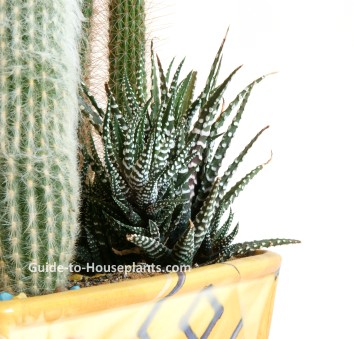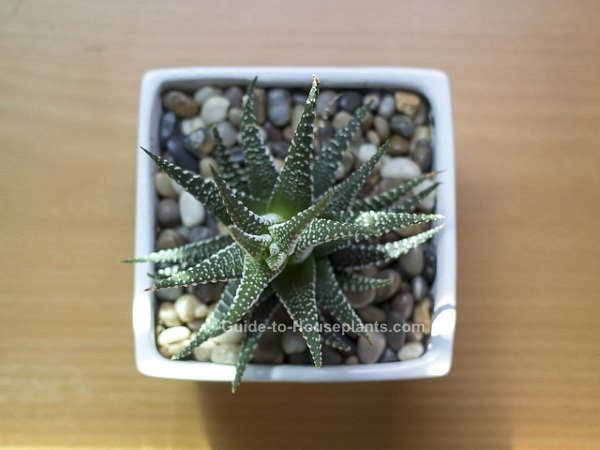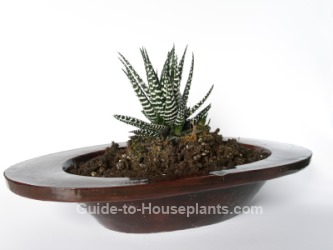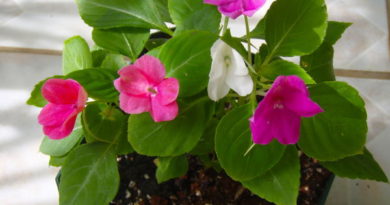Haworthia species – Easy Succulent House Plants, Pictures, Care Tips
Botanical Name: Haworthia species
If you like small house plants, you’ll want to add at least one of these succulents to your collection. This genus offers more than 80 species to choose from and they’re all easy to grow.

This stemless succulent grows in a rosette of fleshy, upright green leaves with sharp, pointed tips.
The markings vary by species and may be striped or spotted. H. pumila is a popular variety featuring pearly white “warts” on its leaves, giving this species the common name “Pearl Plant.” Haworthias are small, making them beautiful additions to succulent and cactus dish gardens.
Some species may flower. The blooms are small and grow in clusters on long stems.
What these succulent house plants have in common is a tolerance for neglect. Put them in indirect light and water occasionally and you’ll keep them happy for several years.
Watch that water. When watering, avoid getting the leaves wet. Like other succulents, its leaves are prone to rot.
Give it a winter rest. Growth slows down in winter, when light levels are lower. Water less in winter and keep your plant slightly cooler. Stop feeding till spring.
Repot in late spring. It’s a good idea to repot every year or two because they shed their old roots each spring, and giving them fresh potting mix will keep the plants healthy. You’ll probably want to propagate offsets at that time anyway.
Haworthias have small roots, so a shallow container will do. If you use a container without drainage holes (as shown below), use it as a cachepot. Slip a plain nursery pot into the cachepot to cover it up. Add a 1-inch (2.5 cm) layer of pebbles at the bottom of the cachepot to keep the inner pot above the drainage water.
 Haworthias are attractive additions to succulent dish gardens — and beautiful all on their own, too.
Haworthias are attractive additions to succulent dish gardens — and beautiful all on their own, too.Buying Tip
Choose plants based on colors and forms you like. They’re all easy to grow.
Want a variety? I knew that you would. Get several. These beautiful South African succulents are a quick way to start or add to your collection.
Haworthia Growing Tips

Origin: South Africa
Height: 3-6 inches (7.5-15 cm) tall depending on species.
Light: Bright indirect light. Unlike most succulents, haworthias don’t like direct sun, which can make the leaves shrivel or cause brown scorch marks. If you move your plant outdoors for the summer months, make the move a gradual one and keep it shaded.
Water: Allow soil to almost dry out between waterings. Try to avoid getting the leaves wet because they may rot.
Humidity: Average room (around 40% relative humidity). Dry air won’t hurt haworthia.
Temperature: Normal room temperatures (65-75°F/18-24°C) spring through fall. In winter, allow plant to rest, keeping it cooler (around 60°F/16°C) if possible.
Soil: Cactus and succulent potting mix works well to provide good drainage. Or combine 2 parts peat-moss based potting mix and 1 part horticultural sand.
Fertilizer: Feed monthly in spring and summer with a fertilizer specially made for succulents. Don’t feed in winter when growth has slowed down.
Propagation: Remove offsets that grow around the plant in spring and pot in their own containers.




